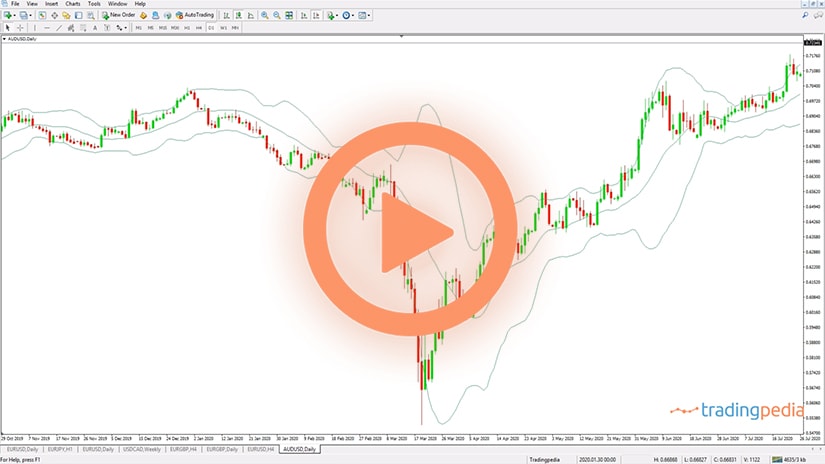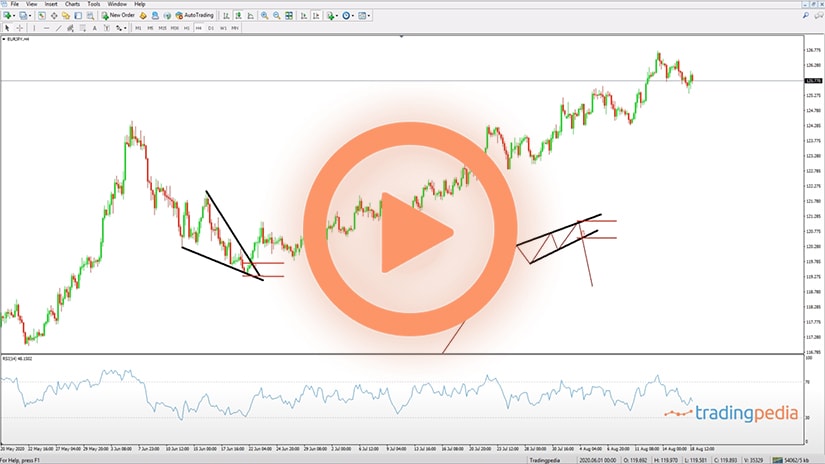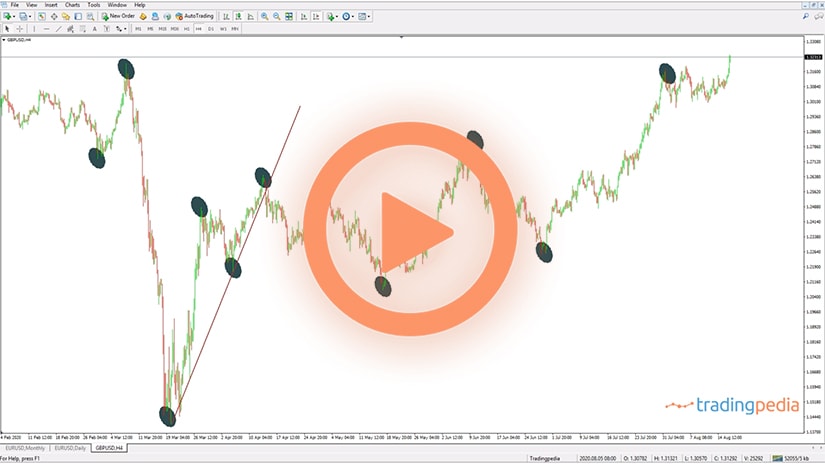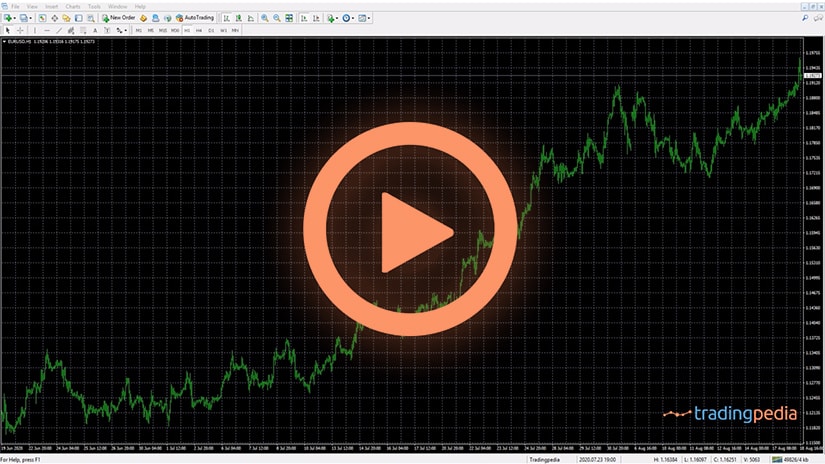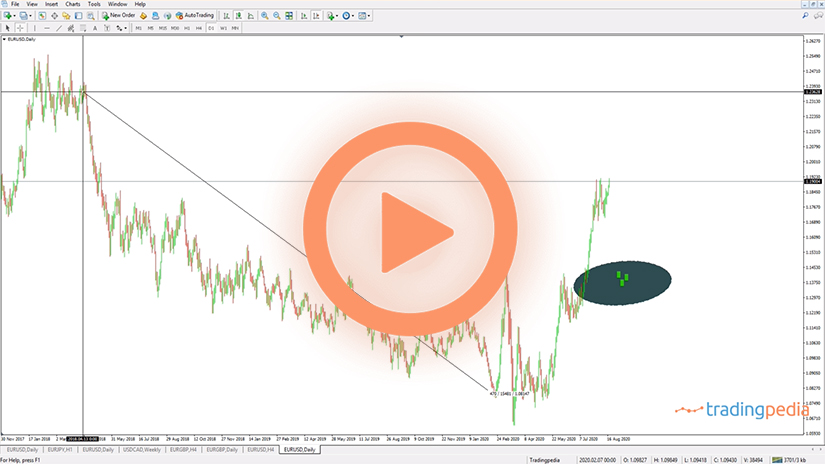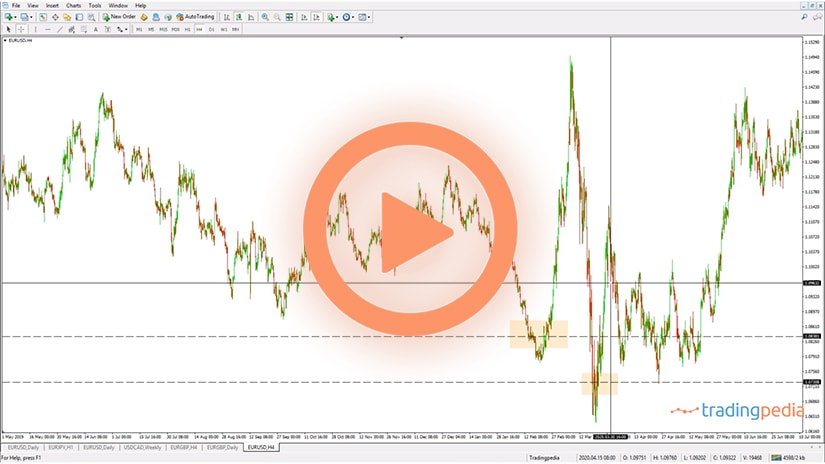
Hello there, this is tradingpedia.com and this video deals with pending orders, when and how to use them, advantages and disadvantages, why should we use pending orders, what types of pending orders exist, and anything that comes to mind relating to pending orders.
What Order to Use
A pending order signals, first of all, the existence of a trading plan, whatever your trading analysis would be. For instance, this is the EURUSD. Let’s assume that we are bullish as the market formed a bullish trend, but we are afraid to buy this dip in the current price action and we want to buy some strength – higher than the current market price – 1.1894. In order to do that, we can use a buy stop order, not a market order.
If we trade the EURUSD at market, we simply push By at Market or Sell at Market after we choose the volume. But we also have the possibility to use pending orders if we want to buy from higher levels or lower levels. Or to sell from lower levels or from higher levels.
Whenever you buy from higher levels, we need to place a pending buy stop order. If we want to buy from 1.1965 because the EURUSD reverses, we want to place a pending buy stop order at the highs to take advantage of that move. A pending order in the MetaTrader4 has no expiration – you have to cancel it. If you are not cancelling it, the MetaTrader4 will execute the order, should the price reach the entry level. If the price never reaches the level, the pending order remains active and it needs to be canceled.
If we want to buy from a higher level, we need to place a pending buy stop order. But let’s say that we are bearish and the move that started here is bearish, the start of a more aggressive move to the downside and we want to make the most of it. At this point, 1.1897 we see that it didn’t break the series of higher lows. Therefore, we want to sell from lower levels.
If we want to sell from a lower level, we want to place a sell stop order. What if we want to sell from higher levels? What if our analysis says, for instance, that this is a zigzag formation and this is a-b-c, the x-wave, next the a-b and then another segment higher, the c-wave? By the time the market makes a new high, we want to sell. In that case, we should place a pending sell limit order and such an order is at a higher level than the current market price.
On the other hand, if we want to buy a currency pair or any market if and when the market reaches a lower level than the current market price, we want to place a buy limit order, meaning that we buy from lower levels.
Pending Orders
These are the four trading types to use when trading financial markets with the MetaTrader4. Other ones exist, like the One-Cancels-Other. With this order, you may place a pending order above or below the current market, and if the market reaches one pending order, the other one gets canceled automatically. But such an order is not in the default settings, you need to integrate a new indicator on the platform – not that it is difficult to do so.
Therefore, keep in mind that if we want to buy from higher prices, we use buy stop orders, and when we want to buy from lower levels, we use buy limit orders. Whenever we want to sell from higher levels, we use sell limit orders, and sell stop orders when we want to sell from lower levels.
A buy stop order takes advantage of the market strength. A sell stop order takes advantage of the market’s weakness. All these four orders signal the existence of a money management, a trading plan. We want to go into the action only if the market reaches certain levels. This is very important because one of the major mistakes that the retail traders do is that because the market is open, they feel the need to do something. Well, sometimes the market just doesn’t move. In fact, it consolidates most of the time, not travelling all the time. Therefore, sitting on your hands is a position that you have on the market, in the sense that you are not willing to risk your capital if the market does not move.
If we place any one of these four pending orders and if the EURUSD spends the next 24h or days without reaching these levels, then effectively we spared the capital because the market did not go anywhere. So that is one advantage of pending orders – it signals money management in place, a trading plan and avoids wasting margin.
Another advantage is that by using pending orders you may influence the way you adjust the leverage and margin in the trading account. If we believe that the EURUSD will move above 1.20 and we place a pending order to buy 1.20 and then the market reverses, we have the opportunity to buy again but only if the market makes a new high with another pending order.
A disadvantage of pending orders is that they are often affected by slippage. Slippage happens when you have an active pending order and then an important economic news, like the NFP in the United States or any news with the potential of creating quick market activity comes and the broker executes your order with a slippage. For instance, if you want to sell from 1.1828 and place a sell stop order but the market falls so fast that the broker will execute the order only when there is a market available. And it may be 1.1825 or 1.1823, and the three pips difference represents the slippage and it is an important cost if you scalp your way in and out of the market for ten pips strategies or something like this.
Related Videos
Pending orders help a trader to mitigate the risk in a trading account and they are of two types – sell limit, sell stop, buy limit, buy stop. If you want to buy from higher levels, you use buy stop orders, if you want to sell from lower levels, you use sell stop levels. And it is always best to use pending orders in other to avoid spending margin and paying negative swaps as most currency pairs have negative swaps. We want to avoid being in a market that does not go anywhere by using pending orders.
Pending Orders – Key to Money Management
A money management system is based on a plan. It means that the trader already knows how much to risk on every single trade, the entry and exit level, and what the next step should be.
The only thing difficult to estimate is the time it takes a trade to reach the target. If the analysis is wrong, the trade may be stopped sooner than expected. Even if the analysis is correct, the market may take an unexpectedly long time to reach the target.
Some patterns do account for time analysis – e.g., flags, pennants, and even the Elliott Waves theory. However, the best way to control the timing and to deploy a sound money management system is to use pending orders.
Plan your trade and trade your plan. This is what using pending orders suggests – a plan is in place.
Traders using a plan have a big advantage in front of traders that use a random system. Yet, building a plan and executing it is a totally different process.
Patience is key. Depending on the timeframe the analysis is based on, it may take days, weeks, or even more until the price reaches the desired level.
Moreover, traders using pending orders are often “ahead of the curve.” Effectively, it means that the market may continue in the opposite direction for some time before reacting.
The beauty of using pending orders is that they allow a trader to:
- Buy into strength – buy-stop orders in trending markets
- Sell into weakness – sell-stop orders in trending markets
- Buy into weakness – buy-limit orders as contrarian trading
- Sell into strength – sell-limit orders as contrarian trading
Pros and Cons of Using Pending Orders
Because a pending order suggests a plan is in place, this helps the risk management strategy. As such, one of the biggest advantages of using pending orders is that risk management improves drastically.
On the same lines, by placing a pending order the trader has an easier time to set and control the risk-reward ratios. It is well-known that the minimum risk-reward ratio must exceed 1:2, meaning that for each $1 risked, the trader stands to gain $2. Thus, by planning where to enter and exit, the trader has an easier task to set the proper risk-reward ratios.
Another advantage is that it avoids overtrading. When using pending orders, the market must travel to a specific level. Otherwise, the order will not be filled. Without pending orders, traders tend to open many trades at market only to see that the price action does not reach the intended level and reverses sharply, triggering losses.
On the flip side, pending orders are skipped if the market gaps up or down. Because there is no market when a gap forms, pending orders, are not executed and so the trader is filled at a different level, affecting the risk-reward ratio.
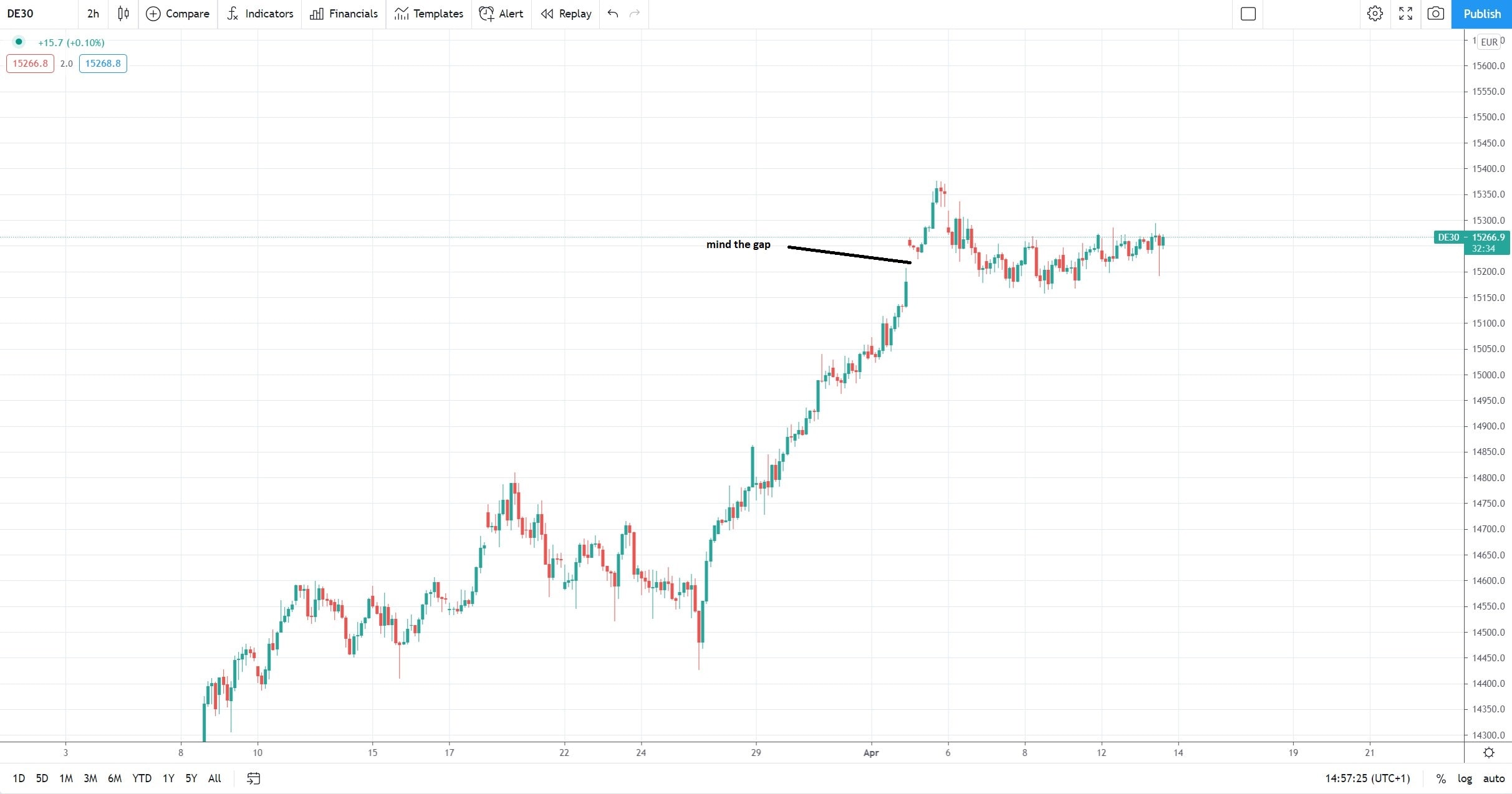
Types of Pending Orders
Below we will present the basic types of pending orders and what they imply. Besides the ones listed below, traders should keep in mind the simplest pending orders that exist – the take-profit and the stop-loss orders.
Unfortunately, not all traders place them for various reasons, such as from the fear that the broker will maneuver prices. That is rarely the case, and so they are mandatory in particular for avoiding big losses.
Pending Buy Stop
Such an order is used to buy from higher levels. For instance, if the EURUSD trades at 1.1975 and has a bullish tone, some traders may expect the momentum to continue on a break above 1.20.
Because the time of the breakout is unknown, a pending buy stop order is recommended. It will fill the order when the price moves higher, regardless if the trading platform was open or not.
Pending Buy Limit
A pending buy limit fulfills the same function, only that the trader expects the market to decline first and then to buy the asset. A pending buy limit order is usually used when trading rising trends, and expecting for the price to decline to support areas provided by a moving average or a rising trendline.
Pending Sell Stop
Sell stop orders are used to sell into weakness. More precisely, think of a descending triangle. The market typically pushes against horizontal support and eventually breaks it.
To make sure they participate in the breakout and to add to the weakness, traders place a pending sell stop order to push the prices even lower.
Pending Sell Limit
Just the opposite is valid when using a pending sell limit order – traders want to sell from higher levels, from resistance. This is particularly useful when trading on the bigger timeframes, such as the monthly chart on the EURUSD pair seen below.
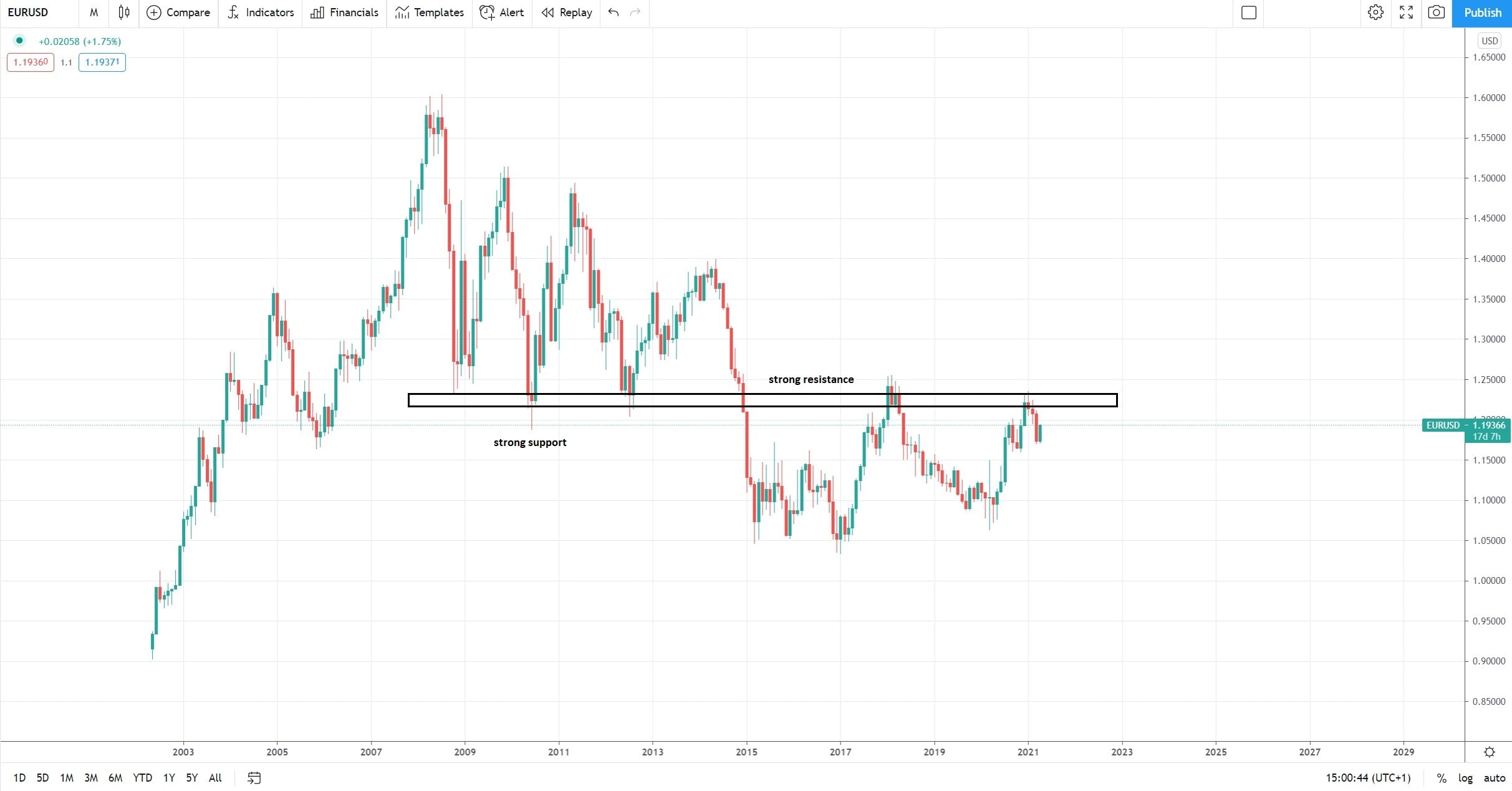
By checking the left side of the chart, traders can spot that the price tries three times to break support in the past and failed each time. Hence, that is a strong support level that should offer resistance. By placing a pending sell limit order by the time the price reaches resistance, they stand to be there on the market’s first reaction.
Trailing Stop, One-Cancels-Other, Fill or Kill
Other types of pending orders exist, such as the trailing stop, the one-cancels-other, or the fill or kill. They are not available on all trading platforms and, most of the time, traders must import some indicators and expert advisors to use them.
Their name is suggestive regarding the function they fulfill, so we won’t go into such details here. It is important only to know that these are complementary pending orders, meant to provide further help in finding the right money management setup.
Trading at Market
As the name suggests, trading at market implies no use of a pending order. Yet, we must mention it here as the root cause of most of the losses incurred by retail traders. As such, if there is something to avoid at all costs, it is trading at market, and not using pending orders.
